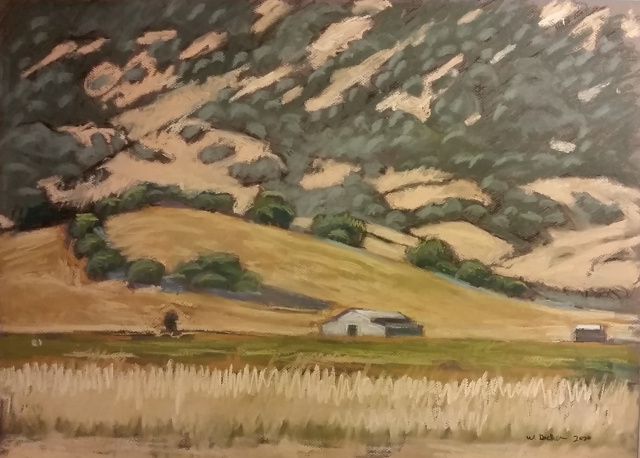Around this time I moved to Boston. In early 1978, a blizzard shut down the city for a week. One of the few places which remained open was the Museum of Fine Arts. I walked from Anderson Street on Beacon Hill all the way to the museum. There was an exhibition of Monet's Early Morning Fog on the Seine paintings. I sat there for hours absorbing the colors while escaping the cold. Monet's work had always been lurking within my conciousness; Haystacks, Rouen, Poplars but that particular exhibition etched his concerns in my mind forever.
Later in 1978 I decided to make the move to California. I left my last East coast studio, a sixth floor walkup with views of Beacon Hill and the Charles River. My last East Coast painting was done in October 1978. I had gone up onto my roof and painted the brownstones in my neighborhood catching the last rays of sunlight. Light and its effects on buildings was still a major concern. One week later I was on my way to California, to see just what it was that had inspired Bischoff, Weeks and Diebenkorn.
Somewhere between Monet, Degas, Hopper, Bischoff and the rest (and my own two eyes) was everything I would ever need to know about light.
In early 1989 California writer Nancy Boas had just completed a book on the Society of Six, a group of early 20th century painters who were heavily influenced by the Impressionist and Fauvist images coming (late) out of Europe. Nancy was giving a slide lecture at Civic Arts in Walnut Creek with images of their paintings. I was immediately overtaken by the work of Gay, Siegriest, Gile, Logan and the rest. Their concern for light and color, combined with a kind of quick painting we would later see from Diebenkorn, Park and Bischoff was like nothing I had ever seen in American painting during that time period. I was living in Concord but had a studio in Benicia where I spent a great deal of time still working in pastel on architectural images from the city. I immediately grabbed my all but forgotten oil paints and started driving to the waterfront in Benicia and Martinez, producing small plein-air images of the local landscape. It was a full circle return to my early images from the East Coast but with the splendor of rural California as the subject matter.
During that time period I met some other Bay Area plein-air painters and began painting with them on a regular basis. Pam Glover and I were in one of our first shows together, “The Outdoor Studio” at Civic Arts in February 1990. The exhibition also included works by Lou and Lundy Siegriest, Jerrold Turner, Terry St. John and Peter Brown. The Outsiders eventually grew out of this exhibition. We added a few other painters, Randy Sexton and Ray Jackson among them, and soon began showing together throughout the Bay Area, including the Triton Museum as well as a show at Hearst Art Museum at St. Mary's College, Moraga.
Thousands of paintings and pastels later, I can reflect on images of the California Delta and other surrounding waterways which have permeated my work and feel the influence of all my heroes; the quick strokes, the immediacy of color and above all, the description of light. I am still doing pastels and oils, both studio and plein-air, and the two mediums continue to provide uniquely different ways of describing the landscape around me.
It's all a continuing and endless concern with time and light and space; paintings as journal entries, marking my days, my time, on the planet.
|
 |
 |